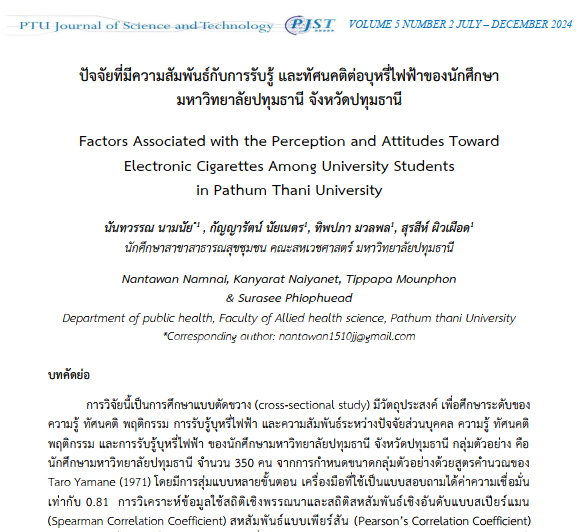Factors Associated with the Perception and Attitudes Toward Electronic Cigarettes Among University Students in Pathum Thani University
Main Article Content
Abstract
This research was a descriptive cross-sectional study aimed at examining the levels of knowledge, attitudes, behaviors and perceptions of electronic cigarettes, and the relationships between personal factors, knowledge, attitudes, behaviors, and perceptions of electronic cigarettes among university students in Pathum Thani Province, Thailand. The study sample consisted of 350 students from Pathum Thani University, determined using Taro Yamane sample size formula, with a multistage random sampling method. The research instrument was a questionnaire with a reliability coefficient of 0.81. Data were analyzed using descriptive statistics, Spearman's rank correlation coefficient, Pearson’s correlation coefficient, and the Chi-square test at a statistical significance level of 0.01. The findings revealed that Knowledge about the perception of electronic cigarettes was at a high level (71.70%). Attitudes toward the perception of electronic cigarettes were at a moderate level (𝑥̅ = 2.26, S.D = 0.405). The smoking behavior is at a moderate level (𝑥̅ = 2.20, S.D = 0.312). Perceptions of electronic cigarettes were at a high level (𝑥̅ = 2.45, S.D = 0.412). Gender was significantly associated with the perception of electronic cigarettes at the 0.05 level. Attitudes (r = 0.429**) and behaviors (r = 0.208**) were significantly correlated with the perception of electronic cigarettes at the 0.01 level. Therefore Effective communication channels, such as social media, should be developed to provide accurate information about electronic cigarettes. Additionally, policies should be designed to educate youth on the risks and dangers of electronic cigarettes to promote healthy decision-making among this group.
Article Details

This work is licensed under a Creative Commons Attribution-NonCommercial-NoDerivatives 4.0 International License.
ความคิดเห็นและข้อเสนอแนะใดๆ ที่นำเสนอในบทความเป็นของผู้เขียนแต่เพียงผู้เดียว โดยบรรณาธิการ กองบรรณาธิการ และคณะกรรมการวารสารวิทยาศาสตร์และเทคโนโลยี มหาวิทยาลัยปทุมธานี ไม่ได้มีส่วนเกี่ยวข้องแต่อย่างใด มหาวิทยาลัย บรรณาธิการ และกองบรรณาธิการจะไม่รับผิดชอบต่อข้อผิดพลาดหรือผลที่เกิดจากการใช้ข้อมูลที่ปรากฏในวารสารฉบับนี้
References
Best JW. (1977). Research in Education. 3rd. Engle Wood Cliff. NJ Prentice Hall.
Bloom BS. (1971). Handbook on formative and summative evaluation of student learning.
Taro Yamane. (1970). Statistics: An Introductory Analysis. (2d ed.). ToKyo: John Weatherhill, Inc.
World Health Organization [WHO]. (2019). Report on the global tobacco epidemic. Retrieved from https://apps.who.int/iris/bitstream/handle/10665/326043/ 9789241516204-eng.pdf
กรมสนับสนุนบริการสุขภาพ. (24 กันยายน 2567). พฤติกรรมการสูบบุหรี่ของเยาวชนไทย.https://hss.moph.go.th/show_topic.php?id=6024.
ณัฐพล รุ่งโรจน์สิทธิชัย. (2560). การรับรู้ ทัศนคติ และพฤติกรรม ที่มีต่อบุหรี่ไฟฟ้า (วิทยานิพนธ์วารสารศาสตรมหาบัณฑิต, มหาวิทยาลัยธรรมศาสตร์). TU Digital Collections. https://ethesisarchive.library.tu.ac.th/thesis/2017/TU_2017_5907011042_8133_8197. pdf
ธนากร ธนวัฒน์. (2567). ผลกระทบในทุกมิติจากการใช้บุหรี่ไฟฟ้าการทบทวนแนวทางการจัดโปรแกรมสำหรับ การสร้างการรับรู้ถึงอันตราย ต่อสุขภาพ และการป้องกันการสูบบุหรี่ไฟฟ้าใน วัยรุ่น. วารสาร สาธารณสุข และ วิทยาศาสตร์ สุขภาพ, 7(2), 93-106.
ธีรังกูร วรบำรุงกุล, เชษฐ รัชดพรรณธิกุล และมนตรี วิชัยวงษ์. (2564). พฤติกรรมและการประเมิน ความเสี่ยงตนเองในการสูบบุหรี่ของกลุ่มบุคลากรและนักศึกษาในมหาวิทยาลัยราชภัฏรำไพพรรณี จังหวัดจันทบุรี. วารสารคุณภาพชีวิตกับกฎหมาย, 17(2), 66-79.
นพรัตน์ รัตนวราภรณ์, ธนพร เบญจพะ, ชวนพิศ ตฤนานนท์. (24 กันยายน 2567). การตรวจสาร นิโคตินในของกลางบุหรี่ไฟฟ้า. กรมวิทยาศาสตร์การแพทย์. http://innovation.dmsc.moph.go.th/InnovationV1.
พิมพ์ชนก คําชู, บัณฑิตา จารี, เบญญาภา ทั่งจ้อย, ปราณี คําวงค์ษา,จีรนันท์ วงศ์ศิลป์ และคณะ.(2567). ความรู้ กับทัศนคติเกี่ยวกับบุหรี่ไฟฟ้า ของนิสิตระดับอุดมศึกษามหาวิทยาลัยแห่งหนึ่งในเขตภาคเหนือ ตอนล่างของประเทศไทย. วารสารการพยาบาลสุขภาพ และ สาธารณสุข, 3(3), 46-54.
พงษ์ศักดิ์ อ้นมอย, อาทิตยา บัวเรือง และคณะ. (2565). ปัจจัยที่มีความสัมพันธ์กับพฤติกรรมการสูบบุหรี่ไฟฟ้าของเยาวชนจังหวัดอุตรดิตถ์. วารสารวิชาการสาธารณสุข, 31(2), S197- S205.
ไพฑูรย์ สอนทน และคณะ. (2565). ความชุกของการใช้บุหรี่ไฟฟ้าและความสัมพันธ์กับการดื่มเครื่องดื่มแอลกอฮอล์ การใช้กัญชา และการสูบบุหรี่ของมัธยมตอนศึกษาตอนปลาย จังหวัดเพชรบูรณ์. (รายงงานฉบับสมบูรณ์) คณะวิทยาศาสตร์และเทคโนโลยี มหาวิทยาลัยราชภัฏเพชรบูรณ์.
ภัณฑิรา ปริญญารักษ์ และ ปรีชญา ตาใจ. (2565) อิทธิพลของข้อมูลข่าวสารต่อพฤติกรรมและการตัดสินใจสูบบุหรี่ไฟฟ้า. วารสารควบคุมโรค, 48(3), 539-550.
วิวัฒน์ โรจนพิทยากร. (2565). สงครามบุหรี่ไฟฟ้า. วารสารวิชาการสาธารณสุข, 31(1), 1-2.
ศิริพร พูลรักษ์. (2565). ผลของโปรแกรมการเลิกสูบบุหรี่ไฟฟ้าผ่านระบบออนไลน์ที่มีต่อความรู้ ทัศนคติ และความตั้งใจเลิกสูบบุหรี่ของนักศึกษามหาวิทยาลัยเอกชนแห่งหนึ่ง. วารสารพยาบาลศาสตร์ มหาวิทยาลัยคริสเตียน, 9(1), 20-38.
อารักษ์ มุ่งหมาย, สริญญา รอดพิพัฒน์และ จินตนา สรายุทธพิทักษ์. (2566). ความสัมพันธ์ระหว่างการเปิดรับข่าวสาร การรับรู้ ทัศนคติ และพฤติกรรมการสูบบุหรี่ไฟฟ้าของนักเรียนชั้นมัธยมศึกษา. วารสารวิชาการมหาวิทยาลัยการกีฬาแห่งชาติ, 15(3), 311-324.


